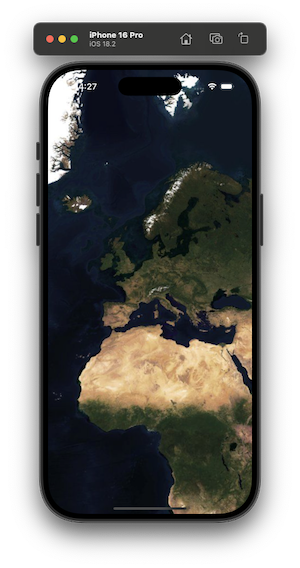Getting Started - Swift SDK
MapTiler SDK iOS is a set of tools for creating and customizing maps on your mobile devices, using Swift language. In this guide you will learn how to add a custom map to your application, style it to your own liking, add points of interest and enable interaction.


First Steps
Open Xcode and create a new project or use existing one (Both UIKit and SwiftUI are supported).
MapTiler SDK is a Swift Package and can be added as dependency through Swift Package Manager.
- File -> Add Package Dependencies
- Add
Once package is added to your project, make sure to set your MapTiler API key, either on app load in AppDelegate or where your project requires it:
Task {
await MTConfig.shared.setAPIKey("YOUR_MAPTILER_API_KEY_HERE")
}
Map Initialization
UIKit
You can add a map to your UIView or UIViewController using MTMapView. Open your view controller and follow the next steps.
On top of your view add import statement:
import MapTilerSDK
Declare map options and map view:
let options = MTMapOptions(zoom: 2.0)
var map: MTMapView!
Initialize the map inside viewDidLoad method:
map = MTMapView(frame: view.frame, options: options, referenceStyle: .streets)
view.addSubview(map)
If you are using auto layout, you can call the helper function for anchors pinning. This ensures correct orientation updates.
map.pinToSuperviewEdges()
SwiftUI
You can add a map to a SwiftUI view using MTMapViewContainer. Open your view and follow the next steps.
On top of your view add import statement:
import MapTilerSDK
Declare variables for your preferred style:
@State private var referenceStyle: MTMapReferenceStyle = .streets
@State private var styleVariant: MTMapStyleVariant? = .defaultVariant
Initialize the map view and add it to your view:
@State private var map = MTMapView(options: MTMapOptions(zoom: 2.0))
var body: some View {
MTMapViewContainer(map: map) {}
.referenceStyle(referenceStyle)
.styleVariant(styleVariant)
}
MapView Delegate
Set your class as delegate for MTMapView and implement the delegate methods:
map.delegate = self
Following methods are available in the delegate:
mapViewDidInitialize(_ mapView: MTMapView)- use to set style and other customizationsmapView(_ mapView: MTMapView, didTriggerEvent event: MTEvent, with data: MTData?)- respond to map data and interaction eventsmapView(_ mapView: MTMapView, didUpdateLocation location: CLLocation)- optionally receive current device location
Interaction
You can interact with the map by calling the methods on the MTMapView object.
Zooming
map.zoomIn()
map.zoomOut()
Navigating
let coordinates = CLLocationCoordinate2D(latitude: 47.137765, longitude: 8.581651)
map.flyTo(coordinates, options: nil, animationOptions: nil)
map.easeTo(coordinates, options: options, animationOptions: nil)
POIs
To add a point of interest on the map, use MTMarker class.
UIKit
let coordinates = CLLocationCoordinate2D(latitude: 47.137765, longitude: 8.581651)
let marker = MTMarker(coordinates: coordinates)
map.addMarker(marker)
SwiftUI
@State private var mapView = MTMapView(options: MTMapOptions(zoom: 2.0))
let coordinates = CLLocationCoordinate2D(latitude: 47.137765, longitude: 8.581651)
var body: some View {
MTMapViewContainer(map: mapView) {
MTMarker(coordinates: coordinates)
}
}
Location Tracking
Optionally, you can enable location tracking by calling:
map.initLocationTracking()
Once location is enabled, you can implement mapView(_ mapView: MTMapView, didUpdateLocation location: CLLocation) delegate method as you see fit.
Learn more
To learn about more advanced functionalities of the SDK, refer to the API reference, or build your own documentation in Xcode: Product -> Build Documentation.
In addition to the documentation take a look at the plug and play examples provided in the SDK GitHub repository, as well as pre-made demo app: